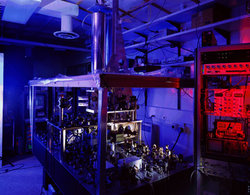|
The Marvels of the Atomic Clock

During the 1950’s a number of these clocks were built that allowed for advanced standardization of time. In 1952, the first clock based on the cesium atom was built. The National Bureau of Standards introduced the NBS-1 (atomic) clock as the national standard for time. Meanwhile, Dr. Louis Essen at the National Physics Laboratory in the UK continued research into (atomic) clocks based upon ammonia. Through the 1960’s the National Bureau of Standards regularly replaced and advanced the models of (atomic) clocks regulating time in the United States. During the 1960’s, the clocks were based upon the cesium-133 atom and in 1967 the second was officially defined as 9,192,631,770 oscillations of resonant frequency of the cesium-133 atom. The current standard clock for the United States called NIST-F1 by the National Institute of Standards and Technology was introduced in 1991 and this atomic clock is accurate to 1 second every 20 million years. With a radio-controlled clock that accesses the Atomic Clock , you can have a clock that automatically sets the correct time, date, and year. Need more information? Back to Clock History. |




